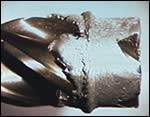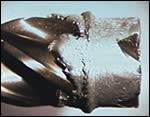What To Consider When Thinking About Solid Carbide End Mill Machining
The selection of geometries and coating for solid carbide end mills can be a confusing, but evaluating the operation will determine which end mills are best for the job.
One of the most confusing aspects about using solid carbide end mills is the selection of many types of geometries and coatings. By understanding what geometries and coatings can or cannot do makes selection as easy as one, two, three. When first deciding which end mill to use, thoroughly evaluate the operation along with the material that needs to be employed to get the desired shape needed. The next step is deciding what geometry will work best.
General Rules
For example, when doing a slotting operation, unless doing a light cut of about .2D or less, it is best to use a two- or three-fluted end mill. The general rule is use less flutes for deeper cuts, with four or higher flutes for light cuts. The reason for this is the venerability of chip packing that can lead to destruction of the end mill. If the machine and program have the ability to trochoid mill, a method which is done by engaging circular arcs using an end mill smaller than the slot width (see Figure 1), a larger number of flutes can be employed. Since the end mill is basically periphery cutting, less heat and forces allow for longer tool life, higher tolerance finishes and increased production over the same amount of time it would take using the conventional method.
When a periphery cut or side mill operation is part of the application and metal removal is of concern, employ a larger number fluted end mill with four, six, even eight teeth. Of course, once again, the radial and axial depth of cut will have a factor in how many teeth to use effectively.
Machining Material
Also, the material being machined must be understood. Since 1018 carbon steel and D2 tool steel don't have the same machining qualities, a different approach must be taken for each. Most end mills will perform just fine for the 1018 with any number of flutes. With harder materials, such as D2 (58 HRc), more flutes, lighter cuts and less speed must be used. The reason for more flutes is because of the lighter feed rates and the need to keep production levels high. Also, as the strength of an end mill increases due to a larger core which helps to decrease tool deflection, different approaches for stainless steels must be used because stainless materials tend to work harden if the feed rate is too low. In aluminum with low silicon percentage (under 5 percent), the material can be a bit gummy leading to built-up edge so high speeds and feeds need to be used to keep the chips evacuating from the flutes. As you can see, the material being used is a dominant factor when deciding speed and feed for all applications. Another consideration is the helix angle of an end mill. It is generally accepted that a 30x angle is industry standard for sharpness and cutting edge strength. This is adequate for carbon steels, some tool steels or even light finishing passes in aluminum. However, when machining stainless steels, a sharper cutting edge needs to be employed as to lessen the work-hardening effects and promote a more free cutting action. This is where a 45x helix angle does well because there will still be some cutting edge strength along with the appropriate sharpness needed. This angle also is good for aluminum when engaging in a deeper slot or periphery cut.
When machining Inconel or other difficult-to-cut materials, a 60x helix needs to be employed. The shearing action is greater, but the tooth edge integrity becomes less. One might think that a weaker cutting edge could cause problems for these materials, but since the feedrates must be kept low, the cutting forces are low enough to maintain cutting edge integrity. Additionally, it might be considered that a sixty-degree angle would be even better for aluminum. That is not the case as the chip flow is not very good because of aluminum's gummy properties, and the fact that the end mill must be run at a high sfm to be effective in cutting aluminum. That combination of speed and the helix angle for this material does not allow for proper chip evacuation.
Considering Coatings
Now, a very important process that allows the carbide end mill to resist wear is the coating. Although solid carbide end mills perform better and last longer in most applications when compared with high-speed steel, heat is not carbide's friend. In the last decade, the technology to provide more heat- and wear-resistant coatings has promoted longer tool life and increased productivity. There are three major types of coatings that are being used today: TiN (titanium nitride), TiCN (titanium carbon nitride) and the increasingly popular TiAlN (titanium aluminum nitride) or AlTiN (aluminum titanium nitride)-the latter having more aluminum content. Other coatings exist, but they are usually offshoots of these three. All of these coatings provide a benefit, but that benefit can only be realized when dealing with specific applications and materials.
TiN-coated end mills should be run at close to uncoated speeds and feeds. The benefit here is much better wear and lubricity. TiCN is a great coating where slow feeds and speeds are used because of machine constraints. It's often the coating of choice for high-speed steel end mills, but in carbide you can run it at least 80 percent faster speed against uncoated solid carbide end mills. The only downfall with TiCN is that it's more prone to failure under extreme heat; hence, it's use in slower feed and speed applications.
The coatings that are becoming more and more popular are the TiAlN- or AlTiN-coated end mills. They are so effective with dissipating heat into the chips that dry machining is mostly recommended, except when slotting where the chips need to be expelled out of the channel. The aluminum in the coating helps form a gaseous aluminum oxide layer at the cutting edge where temperatures can reach more than 1800xF. This helps protect the carbide substrate from the damaging effects of heat. That's what makes this coating ideal for high-speed and hard milling, especially in dry cutting. For machining aluminum, brass, plastics and other nonferrous materials it is best to use a noncoated end mill with polished flutes to prevent edge buildup. This is due to the fact that coated end mills don't allow as sharp an edge needed for these materials.
These are just a few of the factors that lead to productive and consistent solid carbide milling. Other elements that may influence machining could be specific geometries of the end mill that may include certain rake angles, gash lands, relief angles, etc. In addition, the machine, program and stability issues with tool or workpiece setups must be considered. Knowing the basics of geometries and coatings and understanding what they can and cannot do is the first step to helping you decide which end mill should perform best for your application.
Related Content
6 Ways to Optimize High-Feed Milling
High-feed milling can significantly outweigh potential reliability challenges. Consider these six strategies in order to make high-feed milling successful for your business.
Read MoreMoldmakers Deserve a Total Production Solution
Stability, spindle speed and software are essential consideration for your moldmaking machine tool.
Read MoreMachining Center Spindles: What You Need to Know
Why and how to research spindle technology before purchasing a machining center.
Read MoreRevisiting Some Hot Runner Fundamentals
What exactly does a hot runner do? If you’ve been in the injection molding industry for any length of time, you might think the answer is obvious, but it is not.
Read MoreRead Next
Selecting a Carbide End Mill for Aluminum Applications
Specific geometries and characteristics of a carbide end mill are required for efficient machining of aluminum.
Read MoreReasons to Use Fiber Lasers for Mold Cleaning
Fiber lasers offer a simplicity, speed, control and portability, minimizing mold cleaning risks.
Read MoreHow to Use Continuing Education to Remain Competitive in Moldmaking
Continued training helps moldmakers make tooling decisions and properly use the latest cutting tool to efficiently machine high-quality molds.
Read More





















